By Jeffrey A. Rendall, Images courtesy of Mizuno Golf
NORCROSS, GA -- Just admit it… Someone mentions “game improvement irons,” and your panic impulse summonses that little voice in your head screaming, “Game improvement? I’m not that bad – give me the pro-level stuff!”
It’s ingrained in most of us who have played golf for a long time to believe we’re more skilled than we truly are, and that game improvement clubs should rightfully be used by every member of your regular foursome… except for you.
For those of us who learned golf using the old-time forged blades, the looks of the newer vintage cavity-backed irons is a small dose of culture shock. We just don’t want to give up on the notion that what we see is really best for our games.
That’s true to some extent, but to dismiss game improvement technology outright is a mistake. Case in point is Mizuno’s latest offering in the category, the JPX 825 (and JPX 825 Pro, the forged version), which Mizuno bills as the “longest and most forgiving irons” the company has ever created.
Similarly, Mizuno says the JPX 825 Pro irons are the “ultimate combination of Grain Flow Forged feel and forgiveness.”
But there’s more than just forgiveness and playability in these irons -- there’s performance, too. Serious Tour professionals use them as well, with Stacy Lewis (hovering around #1 in the world) being the most noteworthy tour member to put the JPX 825 Pro in her bag.
We tried out the JPX 825 Pro to see for ourselves, and we recently caught up with Mizuno’s Chris Voshall (Golf Club Engineer, Iron Design) to explain the technology behind them:
GolfTheUnitedStates.com: Mizuno delved into the game improvement irons field with the JPX 800 and JPX 800 Pro a few years back – how do the JPX 825 and 825 Pro differ from the 800 versions?
Voshall: Between the 800 and 825 models, we did one thing on the 800/825’s and we did a little bit of the opposite between the 800 Pro and the 825 Pro.
When we developed the 800 and 800 Pro, it was the first time Mizuno focused on high COR (coefficient of restitution) for game improvement irons. The 800 was the cast version of that club, and the casting process really lets you go as thin as possible and you get can get a little more aggressive in the design with the geometry – something like having a flexible area on the sole.
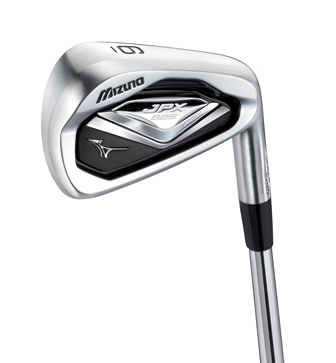 |
And then the 800 Pro was the forged version of that club, where we used a thin-faced forging. The thing we saw between those two clubs – they were both extremely successful – but they were almost a little bit too close in terms of design. The only difference being that one is forged and one is cast.
Spec-wise, they were relatively similar in that the Pro version was not that much smaller, the top-line was still relatively thick, and it kind of had a lot of “game improvement” features on it, even though it was an 800 Pro.
So when we went to the 825 line, what we wanted to do was separate those two a little bit further. Really, for the cast guy, the standard 825 was meant to focus on the things that guy’s looking for: we gave it a little more offset, a little thicker topline, and little bit larger head length from heel to toe -- and even higher COR than the 800.
We pushed the limits of the technology on that club to really get as high a COR as we could.
Yet on the 825 Pro, we did the opposite. The 825 Pro head actually got slightly smaller, and the topline got thinner – especially in the scoring irons. So, we really wanted to push the 825 and the 825 Pro in opposite directions. Where on the Pro, the focus wasn’t as much on COR as it was on feel, seeing as it is a forged golf club, and it is a Pro.
The 825 Pro has the forgiveness built in, but we really wanted to make sure that “feel” was there too.
GolfTheUnitedStates.com: We found the JPX 825 Pro easy to hit, but we also really liked the MP 59 – and found it easy to hit as well.
What would you say is the distinguishing characteristic between the JPX 825 Pro and something like the MP 59?
Voshall: One word: forgiveness. While the MP 59 – you’re right, given its head size, and sole width and topline – it’s really forgiving for what it is. But, when you’re designing a golf club, head size plays so much of a factor into forgiveness.
The easiest way to bump up MOI (moment of inertia) -- also the less-engineering, kind of cheating way – is to make the club head bigger. Just because your trampoline of the face gets bigger, that’s weight further away from the center-of-gravity derived from a larger head. The main difference between the MP’s and the JPX 825 Pro is you get more forgiveness out of the 825 Pros, just based on the specs alone.
But on top of that, as I mentioned, going from the 800 Pro to the 825 Pro, we actually made it smaller but kept the forgiveness by actually focusing on different technologies that would allow us to do that.
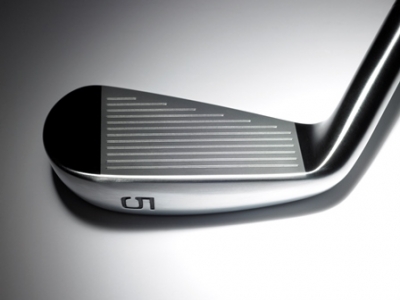 |
So, even though the head specs (on the 825 Pro) look bigger than the MP 59, we went back and milled a pocket cavity in there to bring the center-of-gravity back again. And we also focused on the head shape to really put weight exactly where you need it – out on the toe and heel.
If you look at the JPX 825 Pro from behind, on the sole side of the cavity, there’s weight missing in the center portion -- but it’s there on the heel and toe. Again, we’re doing everything we can to move weight away from that center-of-gravity to really focus on forgiveness.
GolfTheUnitedStates.com: When you’re talking about weight, how much are you looking at moving around from a lay person’s standpoint?
Voshall: The typical 6-iron in our line is about 260 grams -- give or take one or two grams, depending on the model.
So, you’re talking 260 grams, and, taking the 825 Pro for example, before we went back and milled – that head was probably in the 275 range. You end up moving about 15 grams on the finished product. That’s really only about 5% of the overall weight, but depending on where you put it, that percentage plays bigger than that.
Because if you’re focusing weight right in the center, then MOI is not going to move that much.
But if you can take even a couple of grams and shove them to the extremes – like even making the hosel a little bit longer -- that’s pushing weight away from the center-of-gravity. So moving weight to the hosel – you’ll see on the 825 Pro, for example – up on the high toe area, right on the very toe corner, you can see that we focused the mass up there. Again, that’s as far as you can get on that head from the center-of-gravity.
In the end, even though you’re only moving a minimal amount of weight, if you move it strategically, you’re still seeing good increases in forgiveness.
GolfTheUnitedStates.com: In terms of maneuverability, especially compared to your MP models – how would you say that the JPX 825 Pro compares?
Voshall: It’s not going to be quite as maneuverable as an MP iron, mostly because the MOI is higher – meaning, it’s not going to twist as much.
A lot of action that you get on the golf ball is from being able to control the face angle at impact. And as the head gets a little bit longer, the center-of-gravity moves a little bit further from the shaft axis, which makes it not quite as easy to control.
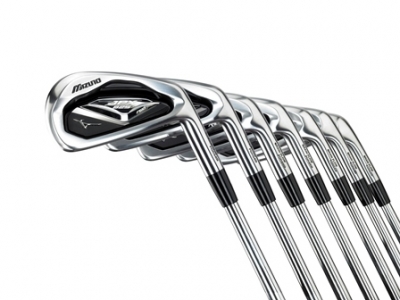 |
As a result, you’re not going to have quite the control level of an MP 59 or MP 64, but in terms of the game improvement category and other clubs that are similar in head size, it’s really forgiving because we kept that center-of-gravity in relatively close to the shaft axis… so you’re still able to knock it down, cut it, and hit draw shots with the JPX 825 Pro.
A lot of the JPX’s maneuverability comes from the fact that we also took offset out of the 825 Pro. Offset is one of those things where, the more offset it is, the more the head kind of likes to act independently and do its own thing and not let you control it as much.
So it’s tough to hit the high shot/low shot or control your up/down trajectory when you have a lot of offset. That’s one of the reasons why from the 800 Pro to the 825 Pro that we took offset out just to increase playability.
GolfTheUnitedStates.com: Looking at the 825 Pro, there’s a pretty significant cavity in back there, yet it’s still a forged club. Have the forging processes evolved so much where you’re able to forge a club that would have only been cast in the past?
Voshall: People will still argue that a cast golf club is easier to hit than a forged golf club – but it’s just the process. It’s what you do after forging that counts.
One of the handcuffs of forging is minimal draft angles, minimum draft angles -- where the forging press has to be able to enter and exit the head. So typically on a forged golf club, you’ll have a 15 degree draft angle everywhere.
So if you have a big deep cavity, you’re thinking like on the sole side, where the sole width is pretty wide, 15 degrees can kick in pretty far in that cavity – which tends to be not as forgiving. Again, that’s more weight moving towards the center of the club.
But by going through and forging it and then milling it afterwards, we’re actually milling it to specs that you would otherwise cast it to. The forgiveness in the geometry is there by what we’re doing after the forging as opposed to the forging itself.
GolfTheUnitedStates.com: Okay. Are forging processes continuing to evolve as well?
Voshall: They really are. The MP 59 is a perfect example of the evolution of forging.
On the MP 59 we forged multi-materials together – there’s no welding or no brazing, any sort of heat treatment to combine the metals. We actually were able to forge one material into another and use their shrink values to actually mechanically lock that Titanium into place.
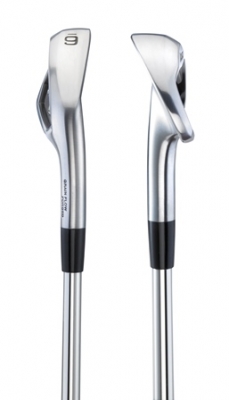 |
On top of that, I was talking about the draft angles that are minimums on forging – where it’s typically 15 degrees from any given view. One of the things we’re really good at – and we’re fortunate to have a forging partner that helps us develop these – we’re actually pressing those boundaries of what you can do with the forging process.
We’ve actually gotten to where we can do what we call undercut forging. That’s where, from a traditional view we’d have a 15 degree draft angle -- we can sometimes get almost a negative draft angle just by how that head is positioned inside the mold.
It’s definitely not like forging was 30 or 40 years ago – or even five years ago, for that matter.
The process keeps getting pushed further and further and you’re able to get better math properties and better geometry because of that.
GolfTheUnitedStates.com: Do you see a time where cast products are going to completely go out because the forging is getting so advanced?
Voshall: There’re still a lot of things you can do with casting that you can’t do with forging in terms of designing something like a super-deep pocket cavity with 3-dimensional things inside the cavity.
That’s something that you’ll never quite be able to get with the forging. And it’s also – and I hate to say it in the golf industry -- it’s so price sensitive. Simply put, forging is more expensive.
There are a lot of guys who will cast something that they could have forged and while the mass properties will still be the same, you won’t get the feeling of the forging.
But a lot of designers are sticking dampeners in the cavity on the badge. So rather than giving you that forged feel – or letting you feel a harsh cast feel – they’re all but taking feel out.
Do I think it could get to where I think casting doesn’t make sense? Absolutely. But it’s cost prohibitive.
GolfTheUnitedStates.com: From a club designer’s standpoint, do you see casting as kind of an ugly step-child in terms of designing a club? Or do you feel that there isn’t as much of a craftsman aspect with a cast club?
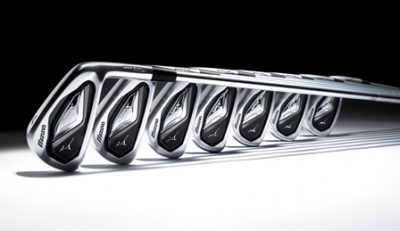 |
Voshall: As someone from Mizuno, I see casting as kind of an ugly stepchild. But… that’s a little bit of a biased view because we are so forged-heavy and forged focused.
We really think we’re the best in the world with forged golf clubs.
With that being said, there’s plenty of good stuff that you can do with casting, and a lot of times, casting makes sense. Depending on the material that you use, you can do thinner on casting. So to get a super-hot face or a super-flexible area on a club, casting allows for a lot of creativity just because you couldn’t forge something as thin.
GolfTheUnitedStates.com: Why is that?
Voshall: When you’re forging something, the material has to have certain qualities that allow it to flow into the mold as it’s pressed. So, there’re still some handcuffs to it. I don’t think it’ll ever…
I don’t know that forgings will ever fully catch castings in terms of what you can do with geometry, but, I’m very much of the opinion that feel is such a big component of a golf club that the feel of a forging is almost always going to beat the feel of a casting.
GolfTheUnitedStates.com: In terms of distance, specifically the JPX 825 Pro – does it continue to evolve in terms of the distance?
Voshall: I think so. Distance is sexy. People love to hit the ball a long way.
Especially when you’re on the JPX side of the world…
Distance in irons is something that is going to continue to evolve, but the frustrating thing in the golf industry is that people are putting out distance simply by changing specs. And it’s really not – there’s less technology driving distance than specs driving distance in a lot of our competitors.
With Mizuno, we’re driving distance with the technology of the golf head. We have the same 6-iron lengths throughout our sets. The loft will vary, and that’s just us playing the game a little bit -- but what’s really frustrating is distance being driven by strong lofts, long lengths and light shafts, where essentially a 6-iron is really a 5-iron.
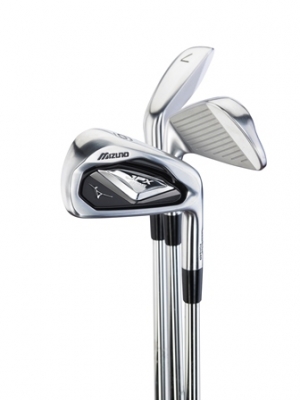 |
I think distance will continue to be sexy, but some of these sets are being pushed so far that it’s beginning to not make any sense. You’re even seeing some of our competitors start to dial it back in loft just because it got so ridiculous.
When you have 2 and 3 degrees differences between your long-irons and 5 degrees between your short irons -- where you need distance control the most -- it makes no sense at all.
So I think distance will continue to evolve, but hopefully it will turn into more technology in the head distance vs. spec distance.
GolfTheUnitedStates.com: Final question – and because Mizuno does not make golf balls, it’s a good and fair question for you: there are your “distance” golf balls and then there are your pro-level golf balls which are not only distance but spin, etc… Is there a type of golf ball that would work best with the types of golf clubs that you like to design?
Or are they pretty much created equal?
Voshall: It’s a great question.
For our MP line, the truest of the true, the player’s line, where the feel is up front, I really think a Urethane covered ball is going to do everything to enhance that feel. It’s going to help with that feel, it’s going to help with the spin, the performance of the club.
Typically a Urethane ball – a Tour level ball like a Pro V1, a B330… something like that – you can do more with it, and it’s going to help you take advantage of what that golf club brings to the table.
And when you’re talking about our higher COR castings (like the JPX 825s), where distance is more of a focus than maneuverability – then that’ll tend to benefit more with Surlyn-covered golf balls. Something like an NXT, or an E6… somewhere along those lines.
While every player’s different in terms of what they’re trying to do, there’re definitely golf balls that will work better to enhance what the golf club brings to the table.
GolfTheUnitedStates.com: If you don’t mind me asking, what’s your personal preference?
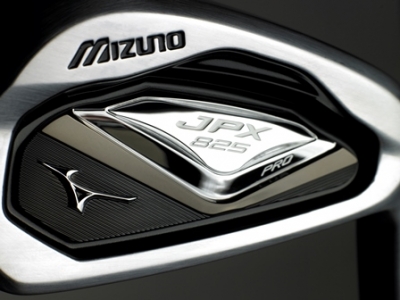 |
Voshall: The cover is so keen in what I’m looking for, in terms of soft feel, or whatever. With a golf ball, I can tell whether I’m going to like it or not before hitting a shot – just by digging my finger nail into it.
_____________________________________________________________________________
One of the great things about trying many of the best golf clubs offered these days is the chance to see how they’re all different. As a long-hitting mid-handicapper, it’s hard to say exactly what makes one club better than others – it’s very much of a personal preference thing.
We don’t endorse products, but I would say playing the JPX 825 Pro has been a very enjoyable experience. They’re very forgiving, and true to Voshall’s word, they’re versatile enough to try and hit certain types of shots in different situations.
The size of the head required some adjustment, since I’m used to playing smaller headed irons – but there’s also some security in using game improvement irons. They’re particularly forgiving on thin shots, which I tend to hit from time to time (or is it all the time?).
Our recommendation would be to try them alongside others in Mizuno’s MP line as well as other high-end clubs that fit your eye. You won’t be disappointed, and the quality of manufacture for these clubs is evident just by looking at them.
Not a bad thing to keep in mind on your next journey to find that perfect blend of forgiveness and feel – and maybe you really will find some “game improvement” of your own.
Details:
Mizuno JPX 825 Pro Irons
Inquire at your higher-end golf retailers and club pro shops. Available in right and left hand with a variety of custom shaft combinations.
Check out more information about Mizuno Golf products at: www.mizunousa.com.
Note: Mizuno has also introduced several other models of irons that merit a look – you can find them on the website.
Mizuno USA, Inc. is a wholly owned subsidiary of Mizuno Corporation, one of the largest general sporting goods manufacturers in the world. Mizuno USA, Inc. manufactures and distributes golf, baseball, softball, running, track & field, and volleyball equipment, apparel, and footwear for North America. Mizuno USA, Inc. is based in Norcross, Georgia.
| Related Links | Comments on this article? | |
|
Maryland National Golf Club Hollow Creek Golf Club Rocky Gap Resort PB Dye Golf Club in Ijamsville Whiskey Creek Golf Club |
E-mail Jeff Rendall, Editor: jrendall@golftheunitedstates.com |












